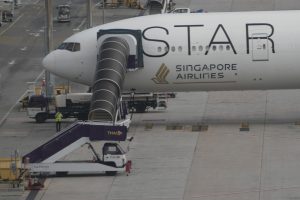The Singapore Airlines flight was at a cruising altitude of 37,000 feet above southern Myanmar when it hit a patch of rough weather on May 21.
The Boeing 777-300ER suddenly lurched upward, throwing unbuckled passengers out of their seats. A few seconds later, the aircraft plummeted into a “terrifying” freefall. An engineer from Sydney who was strapped into his seat compared the experience to hurtling down a “vertical rollercoaster.”
The mid-air scare on SQ321, which lasted less than 5 seconds, was one of the most severe turbulence-related mishaps in commercial aviation.
The death of a 73-year-old British citizen from a suspected heart attack was the first airline fatality involving turbulence in nearly three decades, according to Cirium, an aviation analytics firm. More than 20 people remain hospitalized in Bangkok, where the plane made an emergency landing. A “visibly shaken” pilot appeared to limp into the cabin shortly after the incident.
The London to Singapore flight encountered turbulence over the Irrawaddy Basin. Monsoon winds blowing in from the Bay of Bengal are a known hazard at this time of year. A pilot who declined to be identified told Nikkei Asia that he recently avoided a patch of bad weather along the Singapore route by taking a detour. “We were about 30 miles off track flying around the thunderstorms,” he explained.
David Evans, a former Qantas captain with nearly four decades of experience flying the same route as SQ321, told a Melbourne radio station that pilots typically take a “very conservative” approach towards turbulence even before they take off. Satellite images, accurate weather forecasts, and onboard radar are some of the tools they use to bypass tropical storms.
Chris Hammond, a retired British Airways captain, told the BBC, “If you see a thunderstorm in front of you, you go around it. You don’t go through it under any circumstances.”
A BBC meteorologist said flight recorders could provide insight into why the turbulence incident on SQ321 was severe enough to cause a fatality. He told Times Radio the cockpit voice recorder may reveal whether “there was some sort of technological malfunction which meant that the pilot couldn’t actually get all the information he needed to avoid these huge thunderstorms.”
Singapore’s Ministry of Transport issued a press release on the contents of the aircraft’s flight data recorder and cockpit voice recorder. The preliminary findings indicate that the incident was weather-related and that the plane flew into an area of “developing convective activity,” meaning it encountered an emerging thunderstorm.
A strong updraft likely caused the plane’s “uncommanded” vertical acceleration. The subsequent return to cruising altitude was a sheer drop of 178 feet (roughly the height of a 19-floor building), creating the “roller coaster” effect experienced by passengers.
The statement did not provide details on whether the pilots had access to updated weather information. The investigation is still ongoing.
The press release appeared to rule out climate-induced factors, such as clear-air turbulence associated with the jet stream. A 2023 study by the University of Reading found that the invisible form of turbulence, linked to rising temperatures, had increased along flight routes over the North Atlantic.
However, the air currents that cause clear-air turbulence are uncommon over the Bay of Bengal. Mark Hofmeyer, a Qantas captain, told NCA NewsWire, “You don’t get many jet streams around the equator, which is where this happened.”
The SQ321 incident underscores a frequently overlooked fact about flight safety: planes are better equipped to handle turbulence than people. Aircraft like the Boeing 777-300ER are built to withstand severe weather conditions and are unlikely to suffer catastrophic mid-air damage.
An unbelted passenger thrown into the air at 37,000 feet is a different story. The majority of injuries sustained on SQ321 were related to the head and spine.
As David Evans pointed out, “the human beings within are the most delicate item.”

































